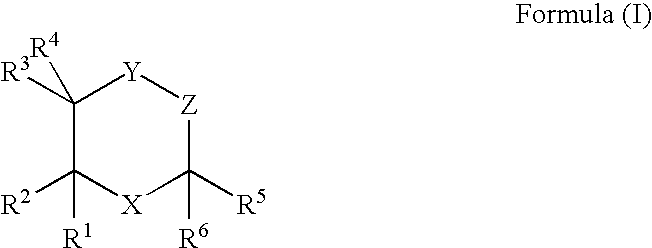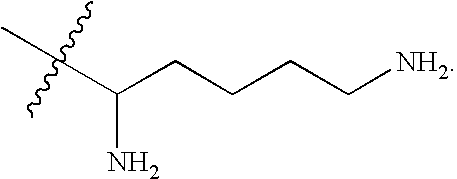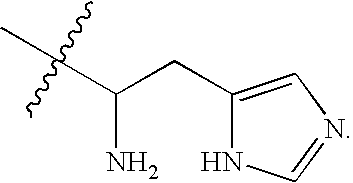Cationic lipids
a lipid and cationic technology, applied in the field of cationic lipids, can solve the problems of affecting the effect of systemic administration, affecting the effect of lipid metabolism, and causing cancer,
- Summary
- Abstract
- Description
- Claims
- Application Information
AI Technical Summary
Benefits of technology
Problems solved by technology
Method used
Image
Examples
example 1
Preparation of 106a: Compound 105a (1.13 g, 1.62 mmol) and HBTU (0.738 g, 1.2 eq.) were taken together in a mixture of DCM / DMF (2:1). To that DIEA (0.732 ml, 3 eq.) was added, stirred the mixture for 5 minutes. N,N-Dimethyl ethylene diamine (0.266 mL, 1.5 eq.) was added and the mixture stirred overnight at ambient temperature. The reaction mixture was added to ice-water mixture and extracted with ethyl acetate. Organic layer was dried over anhydrous sodium sulfate and removed the solvent under reduced pressure. The residue was purified by chromatography (first ethyl acetate then gradient elution 5-10% MeOH / DCM) to get 106a (1.08 g, 84%). 1H NMR (CDCl3, 400 MHz) δ=MS Cal. for C43H82N6O7 794.62 Found: 795.6 (M+H)
Preparation of 107a: Compound 105a (1.04 g, 1.49 mmol) and HBTU (0.680 g, 1.2 eq.) were taken together in a mixture of DCM / DMF (2:1). To that DIEA (0.80 ml, 3 eq.) was added, stirred the mixture for 5 minutes. Histamine (0.250 g, 1.5 eq.) was added and the mixture stirred over...
example 2
Preparation of 111a: Compound 116a (1.10 g, 1.48 mmol) and (Boc)2 histidine (0.785 g, 1.81 mmol) were taken together in a mixture of DCM / DMF (2:1). To that HBTU (0.688 g, 1.81 mmol) was added, followed by DIEA (0.787 mL, 3 eq.). The mixture stirred overnight at ambient temperature. The reaction mixture was added to ice-water mixture and extracted with ethyl acetate. Organic layer was dried over anhydrous sodium sulfate and removed the solvent under reduced pressure. The residue was purified by chromatography (gradient elution 30-80% ethyl acetate / hexane) to get 111a (1.18 g, 77%). 1H NMR (CDCl3, 400 MHz) δ=MS Cal. for C63H116N6O7 1068.89 Found: 1069.9 (M+H)
Preparation of 111b: Compound 116b (1.22 g, 1.595 mmol) and (Boc)2 histidine (0.829 g, 1.2 eq.) were taken together in a mixture of DCM / DMF (2:1, 25 mL). To that HBTU (0.726 g, 1.2 eq.) was added, followed by DIEA (0.832 mL, 3 eq.). The mixture stirred overnight at ambient temperature. The reaction mixture was added to ice-water m...
example 3
Preparation of 112a: Compound 102a (1.00 g, 2.01 mmol) and HBTU (0.837 g, 1.1 eq) were taken in a mixture of DCM / DMF (2:1). To that DIEA (1.04 mL, 3 eq.) was added, the mixture stirred for 5 minutes. N,N-Dimethyl ethylene diamine (0.265 mL, 1.5 eq) was added to that and stirred for 2 hrs at ambient temperature. The reaction mixture was added to ice-water mixture and extracted with ethyl acetate. Organic layer was dried over anhydrous sodium sulfate and removed the solvent under reduced pressure. The residue was purified by chromatography (first eluted with ethyl acetate followed by a gradient elution of 5-10% MeOH / DCM) to get 112a (0.890 g, 78%). 1H NMR (CDCl3, 400 MHz) δ=MS Cal. for C32H62N4O4 566.48 Found: 567.5 (M+H)
Preparation of 112b: Compound 102b (1.05 g, 2.13 mmol) and HBTU (0.852 g, 1.1 eq) were taken in a mixture of DCM / DMF (2:1). To that DIEA (1.10 mL, 3 eq.) was added, the mixture stirred for 5 minutes. N,N-Dimethyl ethylene diamine (0.333 mL, 1.5 eq) was added to that a...
PUM
| Property | Measurement | Unit |
|---|---|---|
| lipophilic | aaaaa | aaaaa |
| diastereomeric mixture | aaaaa | aaaaa |
| compositions | aaaaa | aaaaa |
Abstract
Description
Claims
Application Information
 Login to View More
Login to View More - R&D
- Intellectual Property
- Life Sciences
- Materials
- Tech Scout
- Unparalleled Data Quality
- Higher Quality Content
- 60% Fewer Hallucinations
Browse by: Latest US Patents, China's latest patents, Technical Efficacy Thesaurus, Application Domain, Technology Topic, Popular Technical Reports.
© 2025 PatSnap. All rights reserved.Legal|Privacy policy|Modern Slavery Act Transparency Statement|Sitemap|About US| Contact US: help@patsnap.com



